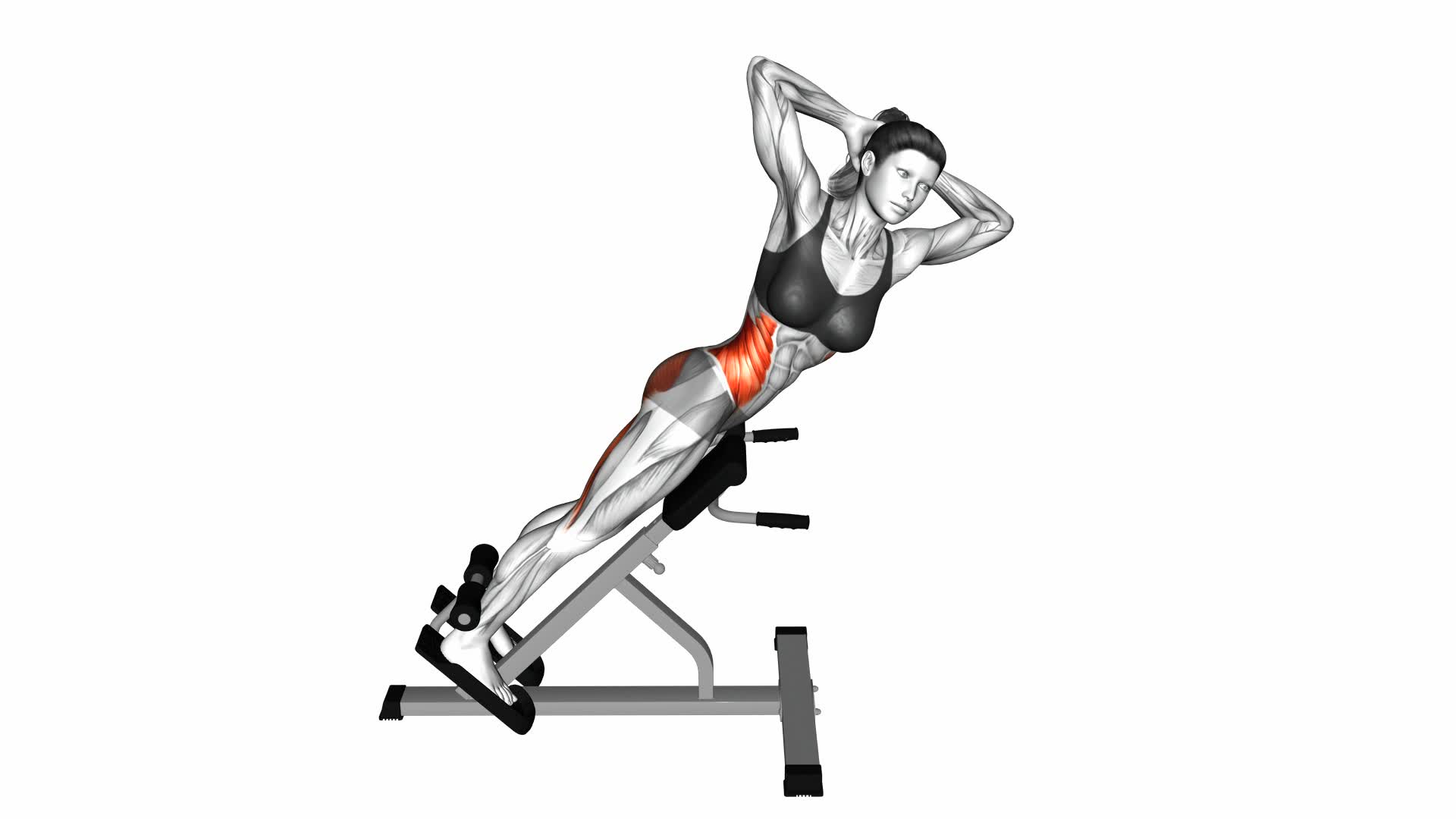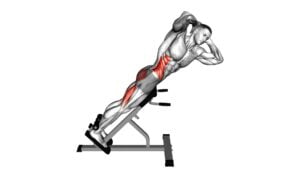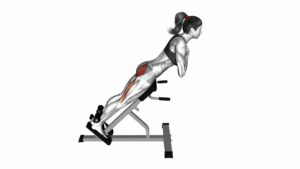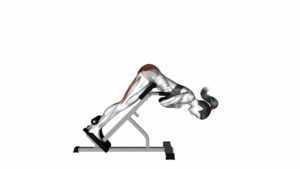45 Degree Twisting Hyperextension – Video Exercise Guide & Tips

Are you looking for an effective exercise to strengthen your core and improve your flexibility? Look no further than the 45 Degree Twisting Hyperextension. This exercise targets your lower back, glutes, and obliques, helping you build a strong and stable core.
Watch This Exercise Video
In this video exercise guide, we'll show you the proper form and technique for performing this move, as well as common mistakes to avoid. Follow our tips to maximize your results with the 45 Degree Twisting Hyperextension.
Let's get started!
Key Takeaways
- Targets lower back, glutes, and obliques
- Builds a strong and stable core
- Engages multiple muscle groups simultaneously
- Can be modified to suit different fitness levels
Benefits of the 45 Degree Twisting Hyperextension
To maximize your workout and strengthen your lower back and core muscles, incorporating the 45-degree twisting hyperextension into your routine offers numerous benefits. This exercise isn't only effective in building strength, but it also helps in injury prevention. By engaging your lower back and core muscles, the twisting hyperextension improves your overall stability and enhances your ability to perform everyday activities with ease.
One of the key benefits of this exercise is that it targets multiple muscle groups simultaneously. It primarily works the erector spinae muscles, which are responsible for extending and rotating the spine. Additionally, it engages the obliques, glutes, and hamstrings, providing a comprehensive workout for your entire posterior chain.
Another advantage of the twisting hyperextension is that it can be modified to suit your fitness level and preferences. If you find the exercise too challenging, you can start with a lower degree of twist or perform it without any added weight. Alternatively, if you want to intensify the exercise, you can increase the weight or add resistance bands for a greater challenge.
Incorporating the 45-degree twisting hyperextension into your workout routine not only strengthens your lower back and core muscles but also helps in injury prevention. As we move into the next section, let's dive into the proper form and technique for this exercise.
Proper Form and Technique for the Exercise
To ensure proper form and technique for the 45-degree twisting hyperextension exercise, follow these guidelines.
One of the most common mistakes beginners make is using excessive momentum instead of focusing on controlled movements.
Remember to engage your core muscles throughout the exercise to maintain stability and prevent strain on your lower back.
Start by lying face down on a hyperextension bench, with your feet securely positioned under the footpads. Place your hands behind your head or crossed on your chest.
As you exhale, lift your upper body while simultaneously twisting to one side, aiming to bring your elbow towards the opposite knee. Keep your movements slow and controlled, avoiding any jerking or bouncing.
Inhale as you lower your body back to the starting position and repeat on the other side.
For beginners, it's important to start with a light weight or no weight at all until you've mastered the proper technique.
Focus on maintaining a neutral spine and avoid overarching or rounding your back.
It's also essential to warm up properly before attempting this exercise to prevent injury.
Step-By-Step Instructions for Performing the Move
To perform the 45-degree twisting hyperextension exercise with proper form and technique, follow these step-by-step instructions.
- Start by lying face down on a hyperextension bench with your hips resting comfortably on the pad and your legs securely hooked under the leg support.
- Place your hands behind your head, or cross them over your chest for added support.
- Engage your core muscles by tightening your abs, then slowly lift your upper body off the pad, keeping your back straight and your neck in a neutral position.
- As you lift, twist your torso to the right, aiming to bring your left elbow towards your right knee.
- Hold this position for a brief moment, then slowly lower your body back down to the starting position.
- Repeat the exercise, this time twisting your torso to the left.
Remember to maintain control throughout the movement and avoid any jerking or bouncing motions.
To prevent injury, it's important to start with light weights or no additional weight at all, and gradually increase the load as your strength and stability improve.
If you experience any discomfort or pain, stop the exercise immediately and consult with a professional.
As with any exercise, it's always a good idea to have alternative exercises that target similar muscle groups. Some alternatives to the 45-degree twisting hyperextension exercise include the standard hyperextension, the bird dog exercise, and the plank.
Incorporating these alternative exercises into your routine can help prevent overuse injuries and provide variety to your workout.
Common Mistakes to Avoid During the Exercise
Avoid these common mistakes to ensure proper form and maximize the effectiveness of the 45-degree twisting hyperextension exercise. By being aware of these errors and making the necessary adjustments, you can prevent potential injuries and get the most out of your workout. Here are five common mistakes to watch out for:
- Rounding your back: Keep your back flat and straight throughout the exercise. Avoid hunching or rounding your spine, as this can strain your lower back and increase the risk of injury.
- Using momentum: Focus on using your core muscles to control the movement, rather than relying on momentum. Engage your abs and glutes to maintain stability and control throughout the exercise.
- Overarching your lower back: Be mindful not to hyperextend your lower back. Maintain a natural curve in your spine and avoid excessive arching, which can lead to discomfort and potential injury.
- Neglecting proper breathing: Remember to breathe steadily and rhythmically throughout the exercise. Inhale as you lower your upper body, and exhale as you lift back up.
- Rushing through the exercise: Take your time and perform each repetition with control and precision. Avoid rushing or using jerky movements, as this can compromise your form and increase the risk of injury.
Tips to Maximize Your Results With the 45 Degree Twisting Hyperextension
To maximize your results with the 45-degree twisting hyperextension, incorporate a weighted resistance or increase the difficulty level of the exercise.
One of the common misconceptions about this exercise is that it only targets the lower back. While it does primarily work the lower back muscles, it also engages the glutes, hamstrings, and core muscles.
To further enhance the effectiveness of the exercise, you can add a weighted plate or dumbbell. Holding the weight against your chest or on your back will increase the resistance and challenge your muscles even more.
Another way to intensify the exercise is by increasing the difficulty level. You can do this by adjusting the angle of the bench or using a stability ball instead. These variations and modifications will challenge your balance and stability, forcing your muscles to work harder.
Remember to maintain proper form throughout the exercise and avoid any jerky or sudden movements.
Frequently Asked Questions
Can the 45 Degree Twisting Hyperextension Exercise Help With Lower Back Pain?
Yes, the 45 degree twisting hyperextension exercise can help with lower back pain. It's considered one of the alternative treatments for alleviating discomfort in the lower back.
This exercise specifically targets the muscles in that area, promoting flexibility and strength. By incorporating twisting motions, it also helps to stretch the muscles and improve mobility.
Is It Safe to Perform the 45 Degree Twisting Hyperextension Exercise if I Have a History of Spinal Injuries?
Safety precautions and modifications should be taken into consideration before performing the 45 degree twisting hyperextension exercise, especially if you have a history of spinal injuries.
It's important to consult with a healthcare professional or a certified trainer to assess your condition and determine if this exercise is suitable for you.
They can provide guidance on proper form, technique, and any necessary modifications to ensure your safety while performing the exercise.
How Often Should I Incorporate the 45 Degree Twisting Hyperextension Exercise Into My Workout Routine?
To incorporate the 45 degree twisting hyperextension exercise into your workout routine, consider the benefits it offers.
This exercise targets your lower back, glutes, and hamstrings, improving overall strength and stability.
Start by performing it once or twice a week and gradually increase the frequency as you become more comfortable.
Always listen to your body and adjust accordingly.
Remember to consult with a fitness professional if you have any concerns or previous spinal injuries.
Can the 45 Degree Twisting Hyperextension Exercise Help Improve Posture?
Improving posture is important for overall health.
The 45 degree twisting hyperextension exercise can be beneficial in this regard. By incorporating this exercise into your routine, you can work on strengthening your core muscles, which play a key role in maintaining good posture.
Additionally, the exercise can help improve flexibility, allowing you to move more freely and comfortably.
Remember to consult with a fitness professional before starting any new exercise program.
Are There Any Alternative Exercises That Target the Same Muscle Groups as the 45 Degree Twisting Hyperextension?
Looking for alternative exercises that target the same muscle groups as the 45 degree twisting hyperextension?
Well, there are a few options you can consider. Engaging in exercises like standing side bends, Russian twists, and woodchoppers can provide muscle activation in similar areas.
These exercises focus on core strength and stability, helping to improve posture and overall body control.
Give them a try and see which ones work best for you!
Conclusion
In conclusion, the 45 degree twisting hyperextension is a beneficial exercise that can help strengthen your core and improve your overall stability. By following proper form and technique, you can maximize the results of this exercise.
Avoid common mistakes and remember to listen to your body to prevent injury. Incorporating the 45 degree twisting hyperextension into your fitness routine can be a great way to challenge your abdominal muscles and enhance your overall fitness level.

Author
Years ago, the spark of my life’s passion ignited in my mind the moment I stepped into the local gym for the first time. The inaugural bead of perspiration, the initial endeavor, the very first surge of endorphins, and a sense of pride that washed over me post-workout marked the beginning of my deep-seated interest in strength sports, fitness, and sports nutrition. This very curiosity blossomed rapidly into a profound fascination, propelling me to earn a Master’s degree in Physical Education from the Academy of Physical Education in Krakow, followed by a Sports Manager diploma from the Jagiellonian University. My journey of growth led me to gain more specialized qualifications, such as being a certified personal trainer with a focus on sports dietetics, a lifeguard, and an instructor for wellness and corrective gymnastics. Theoretical knowledge paired seamlessly with practical experience, reinforcing my belief that the transformation of individuals under my guidance was also a reflection of my personal growth. This belief holds true even today. Each day, I strive to push the boundaries and explore new realms. These realms gently elevate me to greater heights. The unique combination of passion for my field and the continuous quest for growth fuels my drive to break new ground.







